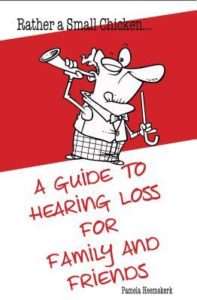Are you a creative non-fiction writer who feels you’ve met continuous blocks to the publication pathway? You may have had your work professionally edited, including for structure, content and flow, but you still can’t find it quite the right home. Today author and health professional, Pamela Heemskerk, shares with us her publication journey for ‘Rather a Small Chicken: A Guide to hearing loss for family and friends’ and her venture into the land of ‘indie’ author. Let’s tune our ears to Pamela’s valuable insights – thanks, Pamela.
 So. You’ve done the hard yards and that book is about ready to put into print. And you decide, like me, that maybe it just isn’t going to top the charts, despite believing the content is publishable. And you can’t face figuring out which traditional publisher to approach and just decide to skip that whole step and DIY as an independent publisher (‘indie’).
So. You’ve done the hard yards and that book is about ready to put into print. And you decide, like me, that maybe it just isn’t going to top the charts, despite believing the content is publishable. And you can’t face figuring out which traditional publisher to approach and just decide to skip that whole step and DIY as an independent publisher (‘indie’).
I wanted help as a first time author with this process, and chose to use a publishing consultant. They will ask you lots of questions during the process of getting the book set-up for printing – things you’ve never thought of in your life. Like where do you want the page numbers to go? Top? Bottom? Left bottom? Middle? Do you want the book title or the chapter heading on each page? How wide a margin? Ummm… What font? Size? And that’s just one page!
You might be tempted to say to the publishing consultant, ‘You decide’, but having got this far, finish well. Take the time to really make it your book.
Illustrations: I decided not to pay an illustrator as there were many suitable pictures available on the web for a small fee. Remember, if you do use an illustration from the web, check if it is free, or whether you need to pay to use the design. Then check if it is royalty free – or you may be paying royalties to the designer every time you use it. This includes marketing or promotion paraphernalia as well as the book itself. A fee can also apply to special fonts for book titles and chapter headings.
Cover: My consultant asked about the cover. I work in health – what would I know about book cover design? Yet, once I started researching and thinking, I found I did have some ideas. I wandered the book shops in town, looking at covers of non-fiction books. What colours were common? What made some covers stand out? What style font and pictures would be distinctive? I knew I wanted something clean and sharp.
I started playing around with cover design, made some rough sketches, and my consultant sent back three options. Strangely enough, I knew straight away which one ‘felt right’ – certainly not the most scientific method to guarantee saleability.
Back Cover: The ISBN must be on there, but will you have reader reviews? Illustrations? Your photo? Plan the wording and layout carefully – this is the second thing people look at after the cover and it’ll either grip them so they open the book, or they’ll put it down.
It’s invaluable to have guidance from someone who knows what makes a book appealing to the market. Be prepared to be little flexible with your idea as the marketer will almost certainly know way more about what will sell than you do.
Bio: Pamela Heemskerk is the author of a short booklet on getting the most out of your hearing aids and promoting communication with hearing loss. She works in allied health. Her book Rather a Small Chicken…A guide to hearing loss for family and friends is available through Amazon as print or e-book.
Bookwhispers: www.bookwhispers.com.au
Well done ladies!!!! I’ll refer to this when my book is ready to be published. 😊
My father loves Pam’s book. It’s been very helpful for him in managing my mother’s deafness. 🙂
I agree that it’s a great resource, Lynne. Pleased your family have found it helpful too.